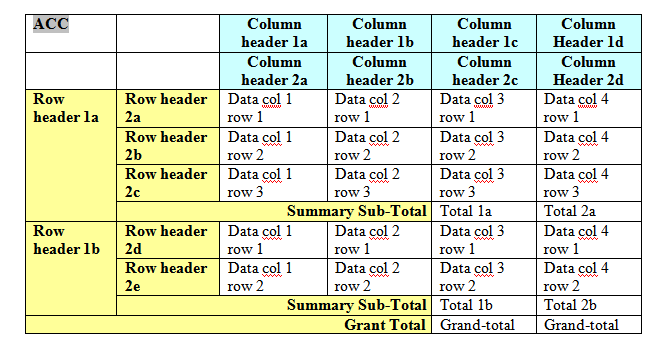Release 11g (11.1.1)
Part Number E13881-01
Contents
Previous
Next
| Oracle Fusion Middleware Report Designer's Guide for Oracle Business Intelligence Publisher Release 11g (11.1.1) Part Number E13881-01 | Contents | Previous | Next |
| View PDF |
This appendix describes techniques for designing reports to increase accessibility of report output to users with disabilities.
Note that accessibility support is for HTML output only.
The following topics are included:
Avoid using nested tables in a report. For a complex report, try breaking down complex tables into several simple, straightforward tables.
The following figure shows a simple table:

The following figure shows an example of a nested table: A table is inserted inside a table-cell:

The following are examples of table structures that BI Publisher does and does not support for accessibility:
BI Publisher does not support accessibility when nested tables are used in a report. In the following example. BI Publisher cannot tell to which column data “C1R1data” belongs:
Unsupported table layout:

Remove the nested table as shown:
Supported table layout:

The following example is not supported because the header, table body and accessibility fields exist in 3 different tables.
Unsupported table layout

These three tables should be joined into one to support accessibility:
Supported table layout

To define or change a document title in Microsoft Word:
In Word 2007: Click the Office button, click Prepare, and then click Properties.
In previous versions of Word: On the File menu, click Properties, and then click the Summary tab.
To define alternative text for an image in your template:
Right-click the image.
On the menu, click Format Picture.
On the Alt Text tab, enter "alt:" followed by the alternative text. For example:
alt:flower pictureNote: In versions of Word prior to 2007, enter the alt:text syntax on the Web tab.
Add a table summary to a table by inserting the following command:
<?table-summary: 'My Table Test '?>in the first column and first row position of the table.
To define a table column header:
In Word 2007:
Select the heading row or rows. The selection must include the first row of the table.
On the Design tab, in the Table Style Options group, select Header Row.
Right-click the table and select Table Properties.
In the Table Properties dialog, click the Row tab and then select Repeat as Header row at the top of each page.
In prior versions of Word:
Select the heading row or rows. The selection must include the first row of the table.
On the Table menu, click Heading Rows Repeat.
To define multiple row headers, use the BI Publisher command:
<?acc-row-header:col_index?> Example Usage:
<?acc-row-header:'1,2,4'?> ==> column 1, 2 and 4 will be row-headers. <?acc-row-header:'1,4'?> ==> column 1 and 4 will be row-headers. In the following figure, the code behind the ACC field is:
ACC Field=<?table-summary:'My Table Test '?><?acc-row-header:'1,2'?>which defines the first two columns as row headers:

The following figures display sample tables for which accessibility is supported:
Double Column and Row Headers

Group Summary Total

Separated Row Headers with Shared Column Header

Separated Row Headers with Individual Column Header

![]()
Copyright © 2004, 2010, Oracle and/or its affiliates. All rights reserved.